Volume 20, Issue 2
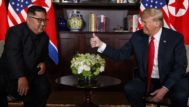
Regional Overview
May — August 2018The Pivot is Dead, Long Live the (Indo-Asia-Pacific) Pivot
In last fall’s National Security Strategy (NSS), the Trump administration began using the term Indo-Pacific to describe an expanded Asia-Pacific region. At this year’s Shangri-La Dialogue in early June, Defense Secretary James Mattis began describing a strategy to fit the region, a “whole-of-government Indo-Pacific strategy that espouses the shared principles that underpin a free-and-open Indo-Pacific.” It differs from, but could encompass the so-called Quad, an informal four-party grouping of regional democracies involving Australia, India, Japan, and the US, which is also based on common values and a common commitment to the rule of law. The strategy accepts and endorses “ASEAN centrality,” a point reinforced by Secretary of State Mike Pompeo during his visit to Singapore for the ASEAN Ministerial meetings and the ASEAN Regional Forum (ARF) in early August. Prior to departing for Singapore, Pompeo laid out “America’s Indo-Pacific Economic Vision” in his speech to the US Chamber of Commerce. While the US is envisioning its economic strategy, the so-called TPP-11 is proceeding without Washington, as is Beijing in pursuing its own more expansive Belt and Road Initiative (BRI).

US - Japan
May — August 2018Summer Before the Storm?
Relations between Tokyo and Washington grew more complex over the summer. The decision by President Donald Trump to meet North Korean leader Kim Jong Un marked a new phase of alliance coordination on the strategic challenge posed by Pyongyang. Trade relations also continued to create an undercurrent of discord. No consensus emerged on a free-trade agreement and the sense that the Trump administration was preparing to impose tariffs not only on steel and aluminum but also on the auto industry added to trepidation over the economic relationship. By the end of the summer, there were signs that the US and Japan were beginning to synchronize their approaches to the Indo-Pacific region as an economic cooperation agenda seems to be emerging. Meanwhile, politics in both capitols this fall make predictions about policy coordination difficult. Prime Minister Abe Shinzo faces his party’s leadership election on Sept. 20, a contest he is likely to win but an opportunity for others in the party to push him on his priorities. In the US, midterm elections promise a referendum on the Trump administration and the increasing turmoil surrounding the White House.
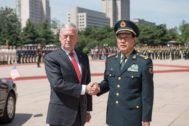
US - China
May — August 2018Tit-for-Tat Tariffs
Negotiations to resolve US-China trade friction failed to produce an agreement and the US-China trade war entered into high gear as both sides imposed tariffs on large quantities of imported goods from the other. President Donald Trump and President Xi Jinping kickstarted their relations with North Korea and held separate meetings with Kim Jong Un. Trump later accused China of undermining progress in US-North Korea negotiations. Secretary of Defense James Mattis traveled to Beijing in mid-June, the first visit to China by a US defense secretary since 2014. On Aug. 13, Trump signed into law the FY2019 National Defense Authorization Act (NDAA), which requires the president to develop a whole-of-government strategy toward China, including how to respond to China’s influence operations, cyber activities, Belt and Road Initiative (BRI), and use of economic tools to gain access to sensitive US industries. The Trump administration pushed back against Chinese bullying of Taiwan.

US - Korea
May — August 2018Singapore Sling to Stalemate
In contrast to last summer’s hot rhetoric and spiking tensions, the United States and North Korea moved to a June thaw with the dramatic Singapore summit. After some heavy lifting from South Korea, Donald Trump and Kim Jong Un produced a vague commitment to denuclearization. By summer’s end there was little progress as North Korea and the US appeared at odds on next steps, with North Korea insisting on a peace regime and the US insisting on visible steps toward denuclearization. South Korea has emerged as the mediator. The US finally saw a new ambassador in Seoul with the appointment of Harry Harris. USFK Commander Gen. Vincent Brooks agreed with ROK defense plans for reducing posts along the DMZ, while joint US-ROK military exercises remained on hold, although Defense Secretary James Mattis hinted at their resumption next year. President Moon’s poll numbers declined, as concerns over slow progress and fissures with the US grew.
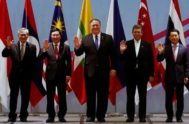
US - Southeast Asia
May — August 2018Caught in the Crossroads of Major Power Tensions
Southeast Asian governments have warmed to the Indo-Pacific concept being promoted by the US, which reinforces their own inclination to expand the cast of regional powers to balance China’s rise. However, they are still wary that a disorganized Trump administration will not be able to translate its rhetoric into policies. In the meantime, they fear being caught between Washington and its Northeast Asian adversaries. Apart from possible clashes between regional powers, Southeast Asia itself offers a number of challenges to smooth relations with the US. Recent elections in Malaysia and Cambodia are two of them, albeit for different reasons. In Indonesia, candidates have been declared for the 2019 presidential elections that could feed growing religious nationalism and anti-Americanism. The Rohingya refugee crisis has ratcheted up tensions between the West and Myanmar over the impact of the 2017 crackdown.
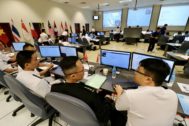
China - Southeast Asia
May — August 2018Assessing China’s Expanding Influence Amid Strong Countercurrents
China’s supporters and detractors tend to agree that China has made substantial gains in recent years in advancing Beijing’s influence in relations with Southeast Asian countries and with ASEAN. Nevertheless, the main countercurrent comes from the United States and its allies and regional partners, along with some ASEAN member states at times showing growing opposition to Chinese policies and practices. At bottom, China’s rise remains contested, the balance of influence in Southeast Asia is in flux, and the outlook is uncertain.
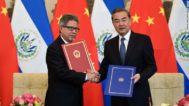
China - Taiwan
May — August 2018Tsai Firm in the Face of Pressure
Beijing has ratcheted up pressure on President Tsai Ing-wen, while also promoting Taiwan’s integration with China. In response, Tsai has strengthened ties with major powers and modestly increased support for defense. Despite Chinese and domestic pressures, Tsai has adhered to her cross-strait policy. Taiwan’s November local elections could have implications for the 2020 presidential election and future cross-strait relations. Beijing remains concerned about US policy toward Taiwan. The Trump administration has taken steps to support Taiwan, but the president appears at times to see Taiwan as an element useful in US-China negotiations. The American Institute in Taiwan (AIT) dedicated its new office building in Taiwan, but no Cabinet official participated.

North Korea - South Korea
May — August 2018Sunshine 2.0: Good Start–But How Far Can It Go?
This summer’s flurry of inter-Korean activity has revived but hardly transcended the kinds of interaction already achieved a decade ago during the “Sunshine” era. There was the return of inter-Korean sports competition and several joint Korean teams competed at the 18th Asian Games in Indonesia. Family reunions in Kumgangsan also returned, which are ultimately a sad commentary on the restrictions placed on personal interactions. Transportation corridors were surveyed and there was talk about future modernization, although hopes of more robust utilization for commerce is hampered by existing sanctions imposed on the DPRK. Military exchanges showed promise with several rounds of talks, but not much action to show for it. With the third inter-Korean summit scheduled, both sides will likely try to find ways to further reduce border tensions while President Moon struggles with his role as mediator between the US and the DPRK.

China - Korea
May — August 2018China’s Multiple Roles in the Korean Drama
Building on the first Xi-Kim summit held in March, Kim Jong Un visited China twice on May 7-8 and June 19-20 for talks with President Xi Jinping, before and after the Trump-Kim summit on June 12. The Xi-Kim meetings affirmed Pyongyang’s commitments to peninsular peace and denuclearization embodied in the April 27 Panmunjom Declaration, but also raised South Korean uncertainties over China’s role and intentions. Although North Korea took its first step toward denuclearization by destroying its Punggye-ri atomic bomb test site, skeptics questioned the significance of the move. Beijing and Seoul forged a favorable environment for regional security cooperation by resuming working-level defense talks. Trilateral talks with Japan also resumed after a three-year deadlock. Despite indications of improving economic and cultural ties, the China-ROK security relationship remains constrained by strategic differences regarding implementation of the peace and denuclearization process.

Japan - China
May — August 2018Warm Words, Underlying Anxieties
Government-to-government relations were cordial over the summer, with the public expression of differences minimized to emphasize their common opposition to US protectionist trade policies. Bilateral trade and tourism posted impressive gains. Both leaders seemed likely to continue in office, though China’s annual Beidaihe meeting of power brokers allegedly criticized the disappointing results of President Xi Jinping’s economic restructuring program, his aggressive foreign policies, and the excesses of his cult of personality. Unimpressive popularity polls notwithstanding, Prime Minister Abe Shinzō had solid support for re-election as president of the Liberal Democratic Party and is therefore likely to win a third consecutive term as prime minister. Abe remained optimistic about receiving an invitation for a state visit to Beijing. However, Japan continued to complain about China’s military expansion and to strengthen its defenses. Summing up China-Japan relations 40 years after normalization, the Yomiuri Shimbun noted that coolness persisted despite bilateral exchanges of people and money.
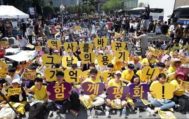
Japan - Korea
May — August 2018Back to Normal Business
Korea-Japan relations returned to normal over the summer months as Pyongyang-Tokyo relations remained at a standstill and Seoul-Tokyo relations followed the dual track approach. For both Pyongyang and Seoul, the primary demand is for Japan to offer an acceptable apology and compensation for Japan’s actions during its colonial rule of the Korean Peninsula. Pyongyang demanded atonement for Japan “war crimes” as the basic condition for the resumption of dialogue between the two countries. Seoul urged Japan to sincerely apologize to Korean women forced into wartime sexual slavery, saying that the issue cannot be resolved diplomatically. Other sources of contention for North Korea-Japan relations are Japan’s support for UN sanctions against the DPRK and Pyongyang’s unwillingness to account for past abductions of Japanese citizens. In the case of South Korea-Japan relations, the disputes over Dokdo/Takeshima and biased history textbooks lingered, although both sides made efforts to strengthen economic, security, and cultural ties despite those issues.

China - Russia
May — August 2018Tales of Two Friends, Two Summits and Two Drills
China-Russia relations gained considerable traction mid-year when Russia’s newly inaugurated “old” president embarked on his first foreign trip to China. In Beijing, the two “intimate” friends hammered out plans to elevate their already “best-ever” relationship against a backdrop of mounting pressures from the US. In Beijing, Putin became the first recipient of China’s newly created “friendship medal” before the two leaders headed for two summits: the 18th SCO Summit in Qingdao in early June and the 10th BRICS Summit in Johannesburg in July. The first major expansion of the SCO was celebrated in Qingdao with an extravaganza. In late August, Russia hosted the biannual SCO Peace-mission 2018 anti-terrorism exercise, while preparing with China, for the first time, for the Vostok series of strategic maneuvering exercises in Russia’s East Military District. Enhanced cooperation between Beijing and Moscow occurred against a backdrop of pressure from the Trump administration.
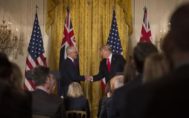
Australia-US/East Asia
September 2017 — August 2018Turnbull Tumbles, Trump Mateship, China Frost
In a week of political mayhem, Australia’s ruling Liberal Party dumped its leader, Prime Minister Malcolm Turnbull, and shunned its deputy leader, Foreign Minister Julie Bishop. While the political unrest is deeply domestic in nature, it shares one element with Australian’s foreign policy concerns – uncertainty. The Australia-US relationship under Donald Trump has been defined by what the president has NOT done to Australia. Trump hasn’t questioned the alliance; hasn’t hit Australia with trade tirades and tariffs; hasn’t broken the refugee deal he so denounced when first taking office; and hasn’t even sent an ambassador to Australia. Canberra’s softly-softly approach to Trump is to talk up the military history – “100 years of mateship” – stressing Australia is an alliance partner that doesn’t cost the US much. A major talking-point is that Australia has a trade deficit with the US. In the way that Trump defines trade relationships, the US makes a profit out of Australia. In contrast, the relationship with China has gone through an icy patch.